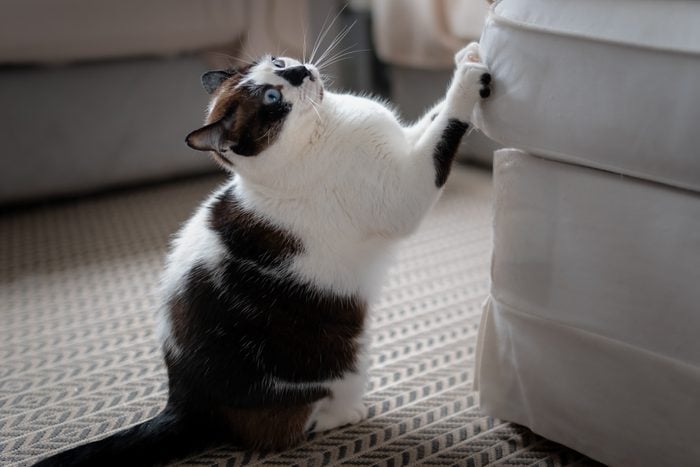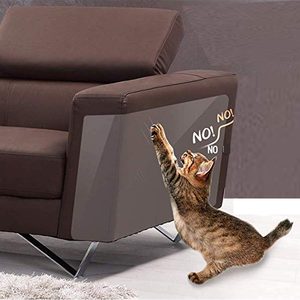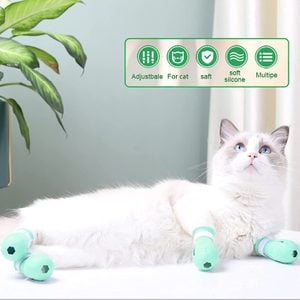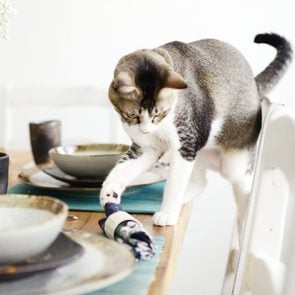Here’s How to Keep a Cat from Scratching the Furniture
Updated: Mar. 11, 2024

Check out these proven ways to keep your cat from destroying your upholstery
Cats—the silly, moody, fluffy little guys we love to love. No matter how cute they are (or maybe how angry they are), much of our cats’ behavior is a mystery to us. Like, why do cats knead? Do cats know their names? And why do they love to tear up our couches and chairs? If you’re wondering about the best cat scratching posts and how to keep cats from scratching furniture, you’re in the right place.
Get Reader’s Digest’s Read Up newsletter for more pet insights, humor, cleaning, travel, tech and fun facts all week long.
Why is my cat scratching the furniture?
Cat body language can be confusing, but scratching is a normal aspect of cat behavior. Here are some possible reasons your cat is scratching furniture.
1. They’re taking care of their nails
In the wild, cats scratch their claws to remove the dead layer of claw (think of it like a cat manicure), which helps to keep their claws sharp for hunting.
2. They’re marking their territory
Scratching also lets them mark their territory. They have scent glands between their claws, and the scratch marks themselves are a visual sign to other cats that this area is occupied.
3. They’re maintaining their physical and emotional well-being
Scratching and stretching also help cats keep their bodies in good shape. Celia Haddon, a cat behaviorist and author of Being Your Cat: What’s Really Going On in Your Feline’s Mind, also says scratching may make a cat feel more emotionally secure in their space.
Can cats be trained not to scratch furniture?
Good news: yes! While experts don’t believe cats can be trained to not scratch at all, they can definitely be trained to not scratch your furniture. As mentioned above, scratching is a primal instinct that helps cats in the wild, so your much-loved cat is simply being a cat. But worry not, there are ways to redirect their instincts.
How do I get my cat to stop scratching my furniture?
It isn’t fun when your feline friend decides to leave their calling card on your furniture, drapes or carpets. Luckily, here are some proven do’s and don’ts for keeping a cat from scratching furniture:
1. Don’t declaw your cat
Declawing your cat is not recommended. It’s a surgical procedure that involves removing the last bone in each of your cat’s toes to prevent the claws from regrowing. Many experts believe it’s an inhumane treatment, plus it can lead to behavior problems such as biting, refusing to use a litter box and even cat anxiety.
2. Provide scratching posts
Kittens begin to scratch at around 8 weeks old, so start training your cat when it’s young by providing scratching posts or stands. Your cat can still indulge in its natural behavior, but without shredding your furniture. Haddon says upright posts should be tall enough for the cat to scratch at full height and stable enough for their claws to sink in for a really good, deep scratch.
A good rule of thumb: Have the post be at least 3 feet tall, with a base width of 1 to 3 feet. And the bigger the cat, the bigger the post should be. Investing in some cat-proof furniture that can withstand all the scratching is also an excellent choice.
3. Use cat scratch spray
Using a cat scratch spray will trick your cat into thinking it has already marked its territory, discouraging it from scratching where you don’t want it to. You can purchase a spray to stop cats from scratching furniture, but it’s also easy to make your own homemade cat scratching spray using vinegar, essential citrus oils or even garlic and peppermint!
4. Use cat scratch tape
If you’re wondering how to stop cats from scratching leather furniture, cat scratch tape is the answer. It also works well on fabric, carpet and hard surfaces such as walls and doors. This double-sided sticky tape comes in panels or rolls like regular tape, and it can be stuck where you need it and removed easily afterward. Cats hate the feeling of stickiness on their paws, so it discourages scratching.
5. Try socks, boots or nail caps
Cat socks or boots (aka mittens) to prevent scratching are an alternative to declawing. These boots work well for some cats, but if yours gets frustrated and keeps trying to remove them, try soft nail caps that glue onto your cat’s claws. These will limit the damage if your cat does decide to scratch where it shouldn’t.
6. Protect with vinyl guards
Yet another option is to install clear vinyl panels on your furniture where your cat wants to scratch. These panels are available in many sizes, and they come with screw pins that make the panels easy to install. Kitties’ claws can’t penetrate the sturdy vinyl, so these covers sleekly provide invisible protection for your cat’s favorite couch or chair.
7. Don’t punish your cat for scratching furniture
Sure, you don’t want your kitty scratching the furniture—but you shouldn’t punish your cat if they do drag their nails across your beloved couch. Haddon says punishing your cat will only stress them out and actually increase the chances of them scratching. “Remember cats have emotional reasons, as well as physical ones, for scratching, ” Haddon explains. “If you make your cat feel anxious, it will scratch all the more!”
While you might not be able to completely keep your cat from scratching furniture, these tips can reduce the likelihood of damage to your home. Next, check out our favorite cat toys and learn why cats hiss.
About the expert
- Celia Haddon is a cat behaviorist and the author of Being Your Cat: What’s Really Going On in Your Feline’s Mind. She holds a bachelor’s degree in applied animal behavior and a master’s degree in clinical animal behavior. She also served as the pets columnist for The Daily Telegraph for 20 years, answering an estimated 100,000 questions on animal behavior.
Sources:
- ASPCA: “Destructive Scratching”
- The Humane Society: “Why declawing is bad for your cat”





